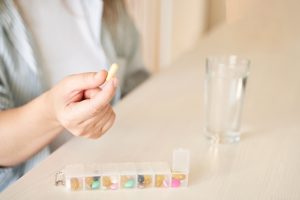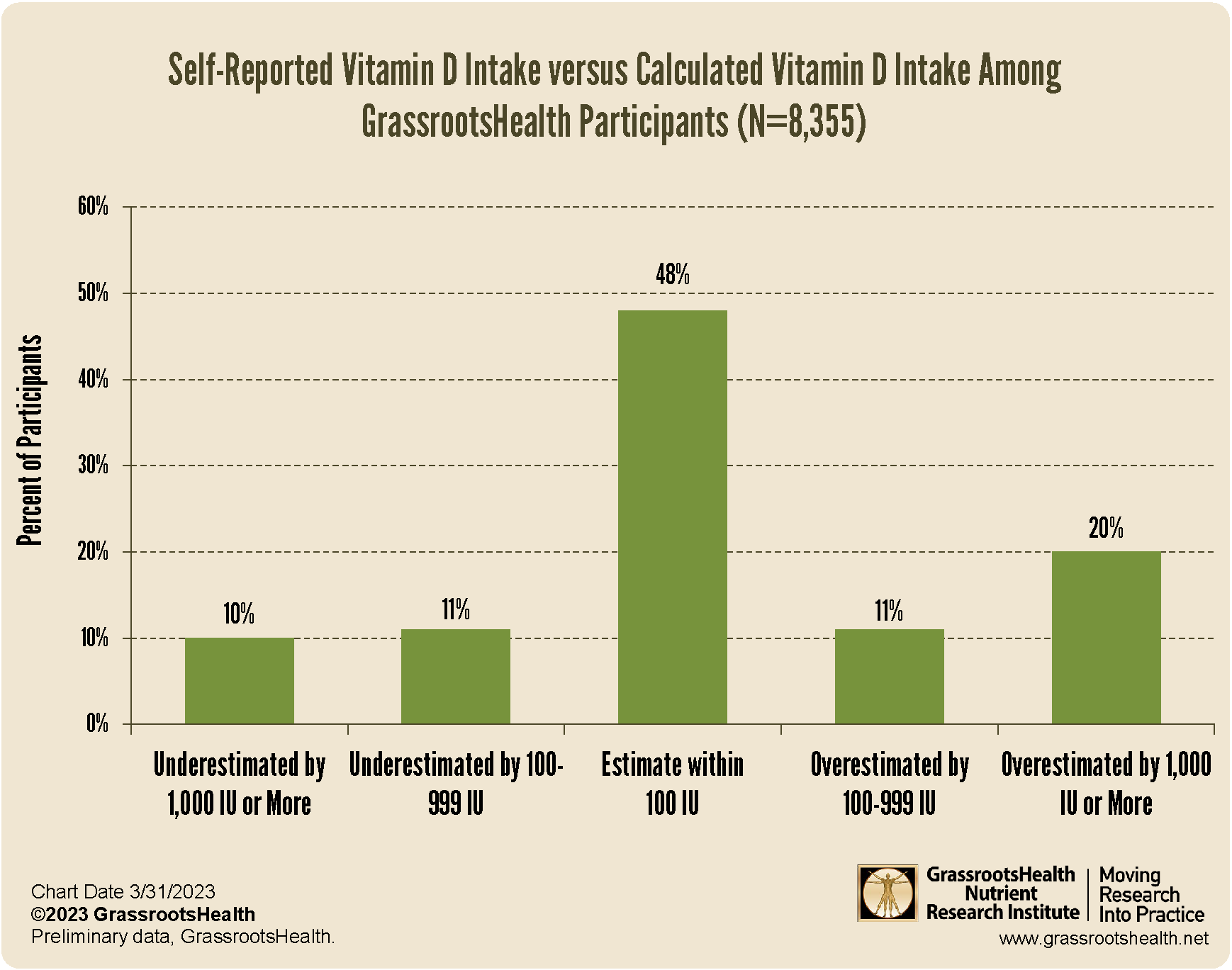Published on April 7, 2023
A new GrassrootsHealth analysis illustrates how well (or how not-so-well) our participants estimate how much vitamin D they take each day
Key Points
- With the information GrassrootsHealth participants report on their questionnaire for each supplement containing vitamin D, we are able to calculate an average daily vitamin D intake and compare it to what they entered separately
- Only 48% had self-reported average vitamin D intakes within 100 IU of the calculated value
- Participants who underestimated their daily intake typically forgot to include the vitamin D from their multivitamin or other non-vitamin D specific supplements that contained vitamin D. Those who overestimated typically put the amount that is on their supplement bottle but did not adjust for the fact that they didn’t take it every day or that they took fewer pills than a full “dose.”
 As part of the GrassrootsHealth questionnaire, all of our participants answer questions that tell us how much vitamin D they are getting on a daily basis from supplements, as well as from sun and indoor UVB. We gather the data for supplemental intake of vitamin D over the previous 6 months by asking for the information in two different ways:
As part of the GrassrootsHealth questionnaire, all of our participants answer questions that tell us how much vitamin D they are getting on a daily basis from supplements, as well as from sun and indoor UVB. We gather the data for supplemental intake of vitamin D over the previous 6 months by asking for the information in two different ways:
- We ask them to enter how much vitamin D from supplements they took per day, on average
- We ask them questions about the supplements they took that contain vitamin D, along with brand/product information, label information, how much they took, how frequently they took it, and for how long
With the information they report on each supplement containing vitamin D, we are able to calculate an average daily vitamin D intake and compare it to what they entered separately. You might be surprised at the accuracy of our participants in estimating their average vitamin D intake!
How Well do Participants Estimate Their Vitamin D Intake?
A total of 8,355 records were included in a preliminary analysis to compare the self-reported vitamin D intake to the calculated supplemental intake amounts.
Calculations were based on the amount of vitamin D for one serving based on verified supplement label information, adjusted for frequency of use and amount taken, for all supplements with vitamin D combined. The supplement nutrition label information was validated by a staff member to make sure what was entered into the questionnaire matched what was on the supplement bottle.
When comparing the calculation to the self-reported intake:
- 48% had self-reported values within 100 IU of the calculated value
- 21% underestimated by 100+ IU (10% underestimated by 1,000+ IU)
- 31% overestimated by 100+ IU (20% overestimated by 1,000+ IU)
What Mistakes Most Often Contributed to Miscalculations?
According to our data, participants who underestimated their daily intake typically forgot to include the vitamin D from their multivitamin or other non-vitamin D specific supplements that contained vitamin D. Those who overestimated typically put the amount that is on their supplement bottle but did not adjust for the fact that they didn’t take it every day or that they took fewer pills than a full “dose.”
What information is important on supplement labels to ensure you get the nutrients you expect to get? Learn more about how to read supplement labels for most nutrients, as well as the information to look for specific to omega-3 supplements.
Another Reason Measuring Your Levels is So Important… Are You Getting Enough Vitamin D?
The only way to know is to test your levels! Testing versus blind supplementation is essential to know for sure if what you are taking is the right amount for you. Once you test your vitamin D (and other levels) to know where you are NOW, you can account for any upcoming changes in lifestyle over the coming months and adjust your intake to reach (or maintain) your targets.
- Vitamin D
- Magnesium PLUS Elements
- Omega-3 Fatty Acids
- hsCRP
- HbA1c
- TSH
- Type 1 Diabetes Autoantibodies
Did you know that each of the above can be measured at home using a simple blood spot test? As part of our ongoing research project, you can order your home blood spot test kit to get your levels, followed by education and steps to take to help you reach your optimal target levels. Start by enrolling and ordering your kit to measure each of the above important markers, and make sure you are getting enough of each to support better mood and wellbeing!
Create your custom home test kit today. Take steps to improve the status of each of these measurements to benefit your overall health. With measurement you can then determine how much is needed and steps to achieve your goals. You can also track your own intakes, symptoms and results to see what works best for YOU.
Enroll in D*action and Test Your Levels Today!







